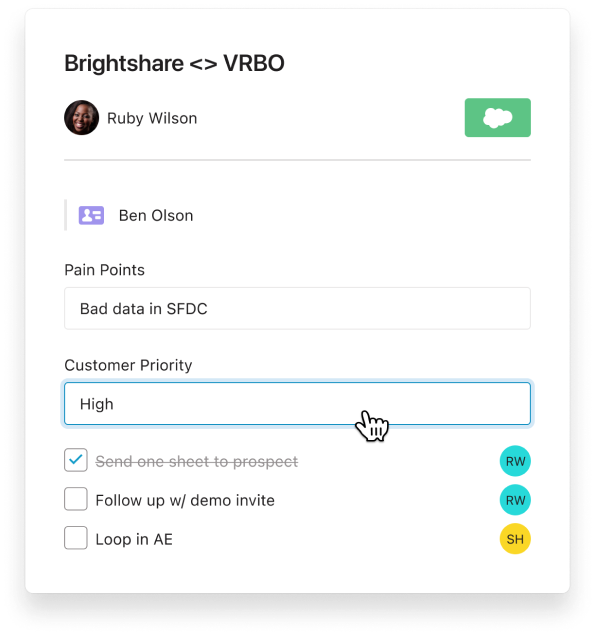
Sales training helps representatives learn new techniques, improve their sales skills, and stay up-to-date on the latest trends in the industry. But just how integral is a good training program to your sales strategy or even the success of your company? And how well do they pay off in the long run?
Learn more about how sales training can influence sales success and how you can benefit from upping your sales training game in 2022.
What are the benefits of sales training?
Sales training provides your sales leaders with the right tools, techniques, and skills to tackle every aspect of the sales process. With proper training, sales professionals can learn and develop effective ways to scope out opportunities, navigate customer interactions, and, of course, close a sale.
So how does this impact your company? It’s simple. Your sales representatives are exactly that – representatives of your brand and your product or service. If your sales leaders know what they’re doing, they give customers a sense of confidence and trust in your brand.
Well-trained sales reps can guide customers through their purchase decisions in a faster and more efficient way, allowing you to hit your company goals faster too. Aside from all this, effective sales training is associated with higher levels of employee motivation, employee satisfaction, and employee retention.
The bottom line? Skilled sales professionals are more efficient at what they do, saving your company time and money in the customer acquisition process.
Finally, a sales process that gives you the freedom to sell.
Use Dooly to keep your deals on track, and your manager off your back.
Try Dooly for free
Sales training trends in 2022
We’ve seen enormous changes across industries over the past three years. As such, sales organizations will have to step up their game and train their sales representatives to adapt to these changes. Here are some training trends you’ll see in 2022:
Self-paced study
The pandemic has made it difficult for sales organizations to maintain synchronous training programs. As a result, self-paced learning has become a popular and viable option for many aspiring sales managers. This setup is convenient although it requires more self-discipline from reps.
Experiential learning
While learning modules and training videos can introduce junior sales reps to the important concepts, nothing compares to learning by experience. Navigating social selling tools, coming up with killer subject lines for sales emails and great headings for websites, and analyzing sales stats can all be done remotely. But some things, like perfecting sales pitches, mastering cold calls, and efficiently closing deals are best learned from a mentor.
In the near future, as we learn more about how to live with and eventually beat COVID-19, we can expect more experiential learning opportunities with potential customers.
15 essential sales training statistics in 2022
1. Companies in the United States have spent an estimated $70 billion on training per year.
[Source: Salesforce]
2. Companies that invest in training are 57% more effective at sales than their competitors.
[Source: Task Drive]
3. On an individual level, sales training can boost sales representatives’ performance by an average of 20%.
[Source: Spotio]
4. Sales training reaps a staggering 353% ROI for the average company.
Or you can think of it this way: for every $1 your company spends on training, you can get up to $4.53 in return!
[Source: Task Drive]
5. Continuous training is said to result in 50% higher net sales per sales rep.
Successful sales teams are created with continuous training, not one-off seminars.
[Source: The Brevet Group]

6. 80% of high-performing sales teams say they would rate their training as very good or outstanding.
Thus proving that a well-executed sales onboarding program creates high-performing sales teams.
[Source: Salesforce]
7. High-growth companies are twice as likely to provide customized training to their employees, depending on their sales roles.
Personalized training is believed to be the future of sales training. Rather than offering one-size-fits-all programs, companies should work towards offering experiential opportunities that are attuned to the sales rep’s skill set and interests.
[Source: Uplead]
8. Only 17% of companies say they have an effective training program.
[Source: Task Drive]
9. Over a quarter of all sales representatives say that their company’s sales training offered little to no benefits in their productivity.
A good number of sales training programs only cover basic sales skills, leaving sales forces to learn on the job.
[Source: Task Drive]
10. Companies will spend an average of $10,000 to $15,000 to hire one employee but will only shell out $2,000 in sales training per year.
This is perhaps the biggest indicator of why over a quarter of sales reps are disappointed in their training programs. Without proper funding, the quality of training programs suffers.
[Source: Uplead]
11. Nearly 70% of all salespeople say they have not received any formal training in sales – instead, they describe themselves as “self-taught social sellers”.
This means there is a huge opportunity for those looking to offer sales training services as a business.
[Source: Task Drive]
12. Almost half (46%) of sales reps didn’t plan on establishing a career in sales initially.
As such, a huge chunk of junior sales representatives need effective sales coaching before they can be ready. After all, not everyone has the instincts or selling skill sets necessary from the outset.
[Source: Uplead]
13. For the majority of sales professionals, 84% of their sales training is forgotten within three months.
As mentioned, continuous training is important for a company’s overall performance. If you want to join the ranks of high-growth companies, you should invest in continuous training programs for all your sales reps.
[Source: Spotio]
14. For 59% of American companies, the biggest obstacle to providing effective sales training is accountability.
When sales representatives are not held accountable for applying the skills they gathered from the program, their training easily goes to waste.
[Source: Brain Shark]
15. Sales enablement can lead to a 6% to 20% increase in sales.
High-performing sales organizations invest in sales enablement services.
[Source: Learn G2]
Conclusion
In 2022, sales training will be more important than ever. As the market changes and gets even more competitive, you’ll need to empower your employees to focus on increasing their own skillset and stay ahead of the curve. We hope these sales stats can help you figure out how to move forward with your training in 2022.
Aside from sales training, you can also improve your reps’ efficiency by arming them with an effective sales tool like Dooly. Save your sales team 5+ hours in Salesforce grunt work every week. [Demo Dooly]
The more sales call stats you have in your pocket, the easier it becomes to set weekly or monthly optimal targets. If you could use sales call templates and an AI-sales coach with you guiding you through every call, demo Dooly today.
Want even more sales stats?
Want to hit your annual quotas sooner than expected? Here is a list of sales statistics articles you should read before you kick off your sales strategy for 2022:
- 40 Sales Statistics You Need to Know in 2022
- 15 Sales Follow Up Statistics You Need to Know in 2022
- 15 Sales Closing Statistics You Need to Know in 2022
- 14 Sales Funnel Statistics You Need to Know in 2022
- 20 Sales Call Statistics You Need to Know in 2022
- 16 Sales Conversion Rate Statistics You Need to Know in 2022
- 20 Sales Enablement Statistics You Need to Know in 2022
- 20 Sales Cold Calling Statistics You Need to Know in 2022
- 9 Sales Forecasting Statistics You Need to Know in 2022

FAQ
How big is the sales training industry?
According to the Rain Group, the global market for sales training is $4.6 billion.
How does training affect sales and business growth?
Sales training results in a 353% ROI. Aside from helping one hit their revenue targets, training also benefits companies by improving employee satisfaction, customer satisfaction, and customer retention. However, the success rate of a sales training program depends on the effectiveness of the sales experts conducting the training, the frequency of training programs, and the willingness of sales executives to fund such programs.
What are the different types of sales training?
The four categories of sales training include inside sales training, field sales training, service sales training, and sales management training.
Join the thousands of top-performing salespeople who use Dooly every day to stay more organized, instantly update their pipeline, and spend more time selling instead of mindless admin work. Try Dooly free, no credit card required. Or, Request a demo to speak with a Dooly product expert right now.


